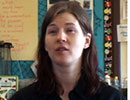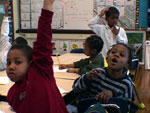Join us for conversations that inspire, recognize, and encourage innovation and best practices in the education profession.
Available on Apple Podcasts, Spotify, Google Podcasts, and more.
 “A good class is fully engaged, they want to do the experiments, the questions, the answers. They’re into it. You can see it on their faces, the discovery and the excitement. And you know that they’re learning, because if you ask them a question, they just go on and on and on. And it makes the class go by fast, and I’m like, wait a minute, stay longer…”
“A good class is fully engaged, they want to do the experiments, the questions, the answers. They’re into it. You can see it on their faces, the discovery and the excitement. And you know that they’re learning, because if you ask them a question, they just go on and on and on. And it makes the class go by fast, and I’m like, wait a minute, stay longer…”
Stephanie Selznick is a science specialist at the Oliver Wendell Holmes Elementary School in Dorchester, MA, an area of Boston located southwest of the city proper.
The school is part of the Boston Public School system, which is one of the largest in the country. The school serves a minority population–about 81% of the students are black, 13% Hispanic, while the rest are divided between white and Asian students. In total, 250 students are enrolled at the school and, as a science specialist for her school, Stephanie sees each of them once a week.
 Lesson at a Glance:
Lesson at a Glance:
Curriculum: Science & Technology for Children, National Science Resources Center, Carolina Biological Supply Center
Topic: How are plants and animals alike and different?
Grade: First
In Program Two, Stephanie taught a lesson from the Organisms unit of the Science and Technology for Children (STC) curriculum to a group of first graders. The students had recently been learning about the characteristics of living things, and had spent time observing different organisms in the class aquariums and terrariums. Stephanie wanted to get them to think about the essential characteristics of plant and animal life and about the differences between them.
Starting with two charts, Ms. Selznick asked the class to consider how all plant life is alike and different. “Typically, I’ll take two plants and put them on the counter and ask, how are these two alike? Then I’ll have them compare them to trees outside, or to the tulips we planted in the fall.” Through discussion, her students’ ideas, often misconceptions, surface: “that all plants have flowers, or branches, or that plants breath oxygen,” said Stephanie.
After her students conducted the same activity for animals, Stephanie had them discuss the similarities and differences between plants and animals while she recorded their observations on a Venn diagram at the front of the room. Finally she had the class record what they thought were the five basic needs of both plants and animals.
The lesson required the students to work hard on classification: they needed to determine how each group of organisms was alike and different, and then to classify them based on their essential characteristics. “When I start off with classification in the first grade,” said Stephanie, “I start small and with something they can handle, like M&Ms or buttons.” Her students classify them based on color, shape, or number of holes, while she records the differences in charts at the front of the class. As her students advance, the classifications become more difficult and she also has her students write up their observations. “By the time they’re in fifth grade, it’s like they are going to be absolutely perfect at observation. And that goes back to classifying,” said Stephanie, “It all starts with what they observe – that is classification.”
 Lesson Goals:
Lesson Goals:
Consider the goals for this lesson as listed above. How can you create a lesson appropriate for your classroom that will fulfill similar goals?